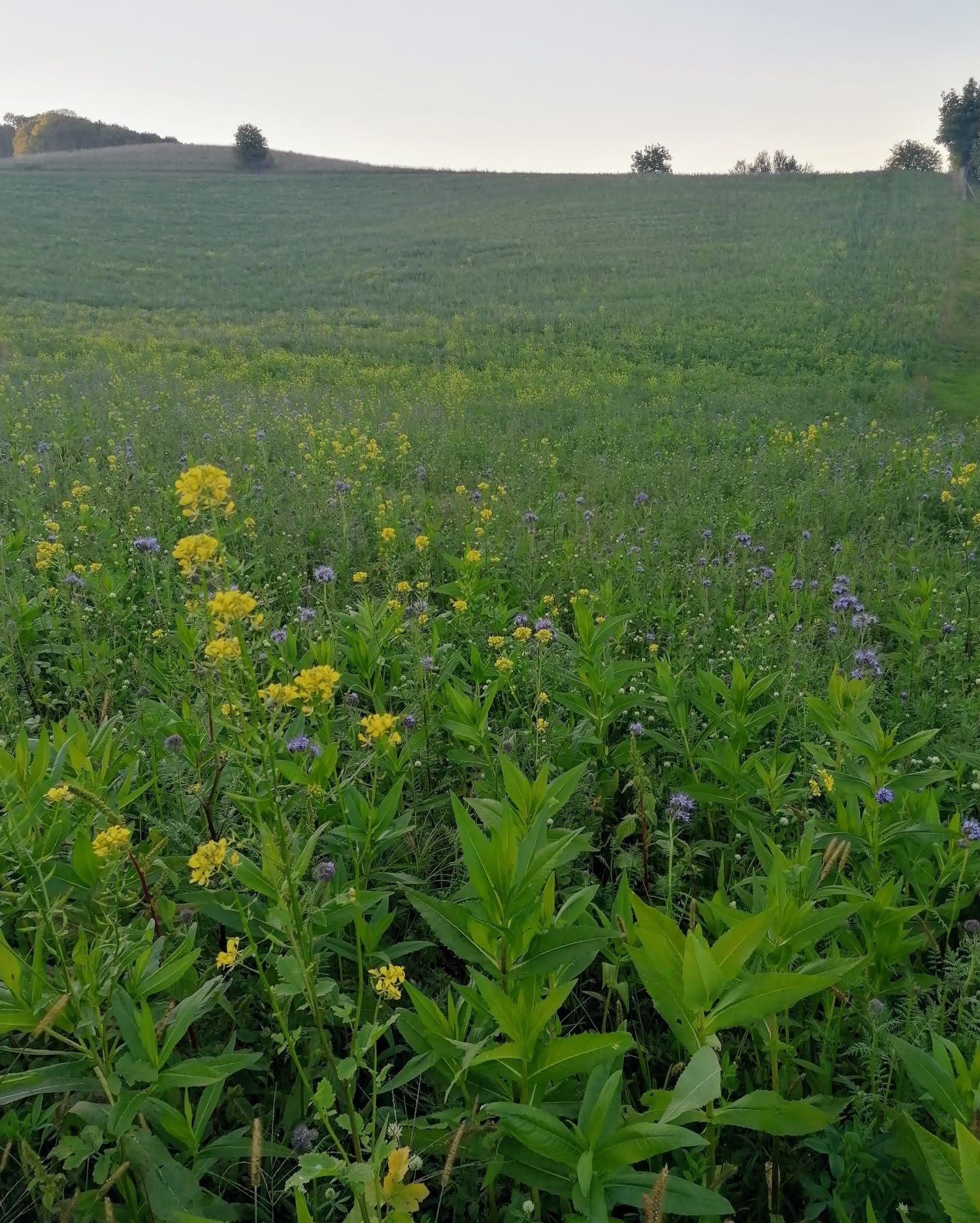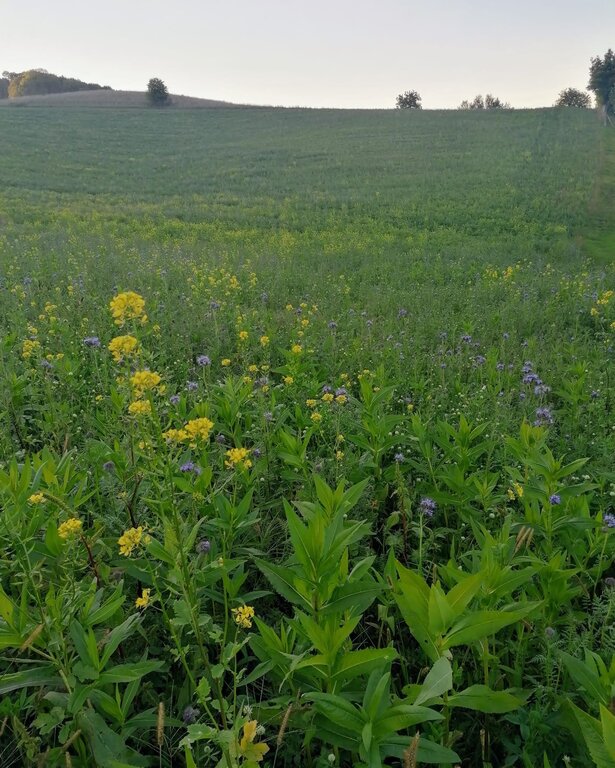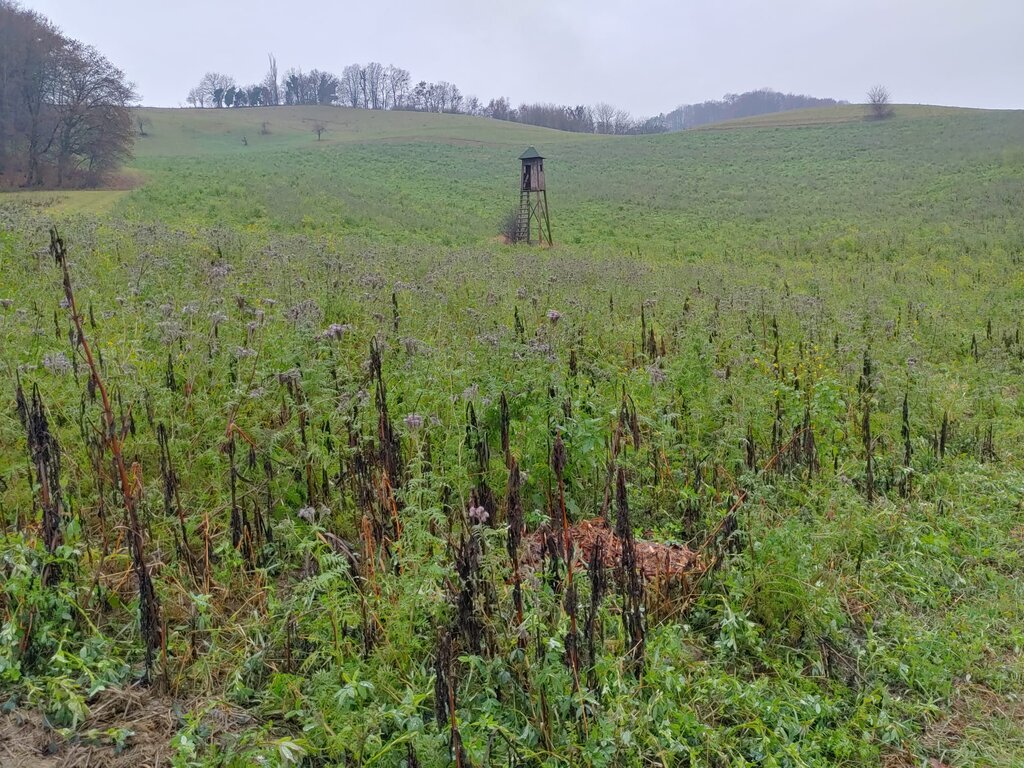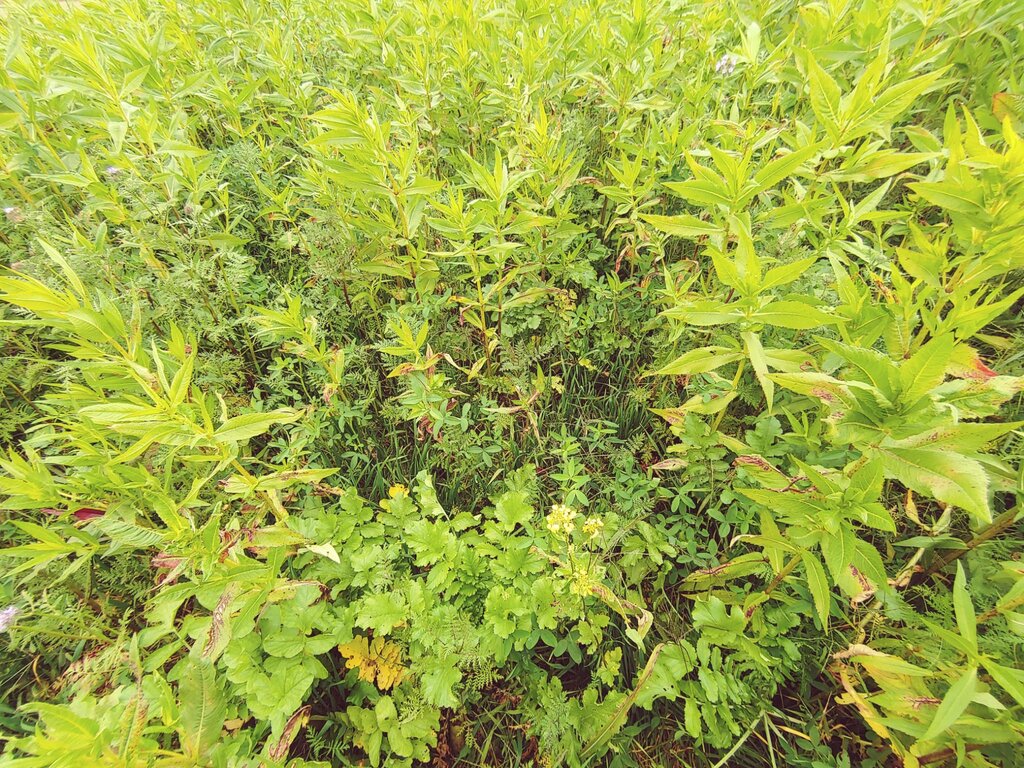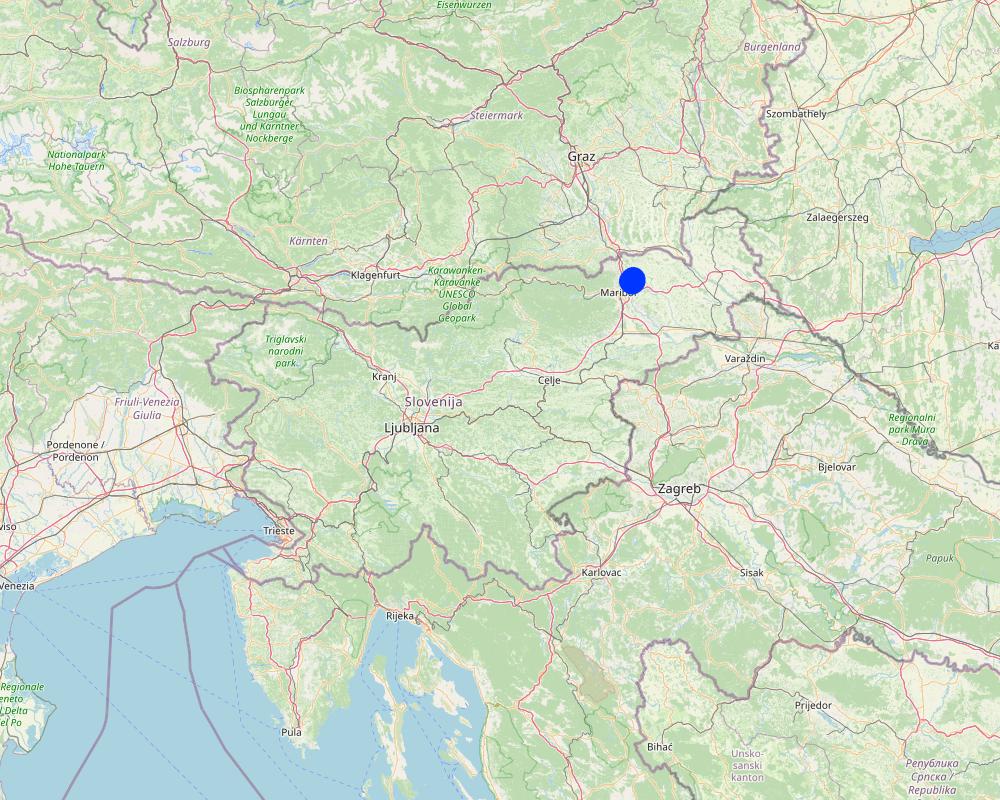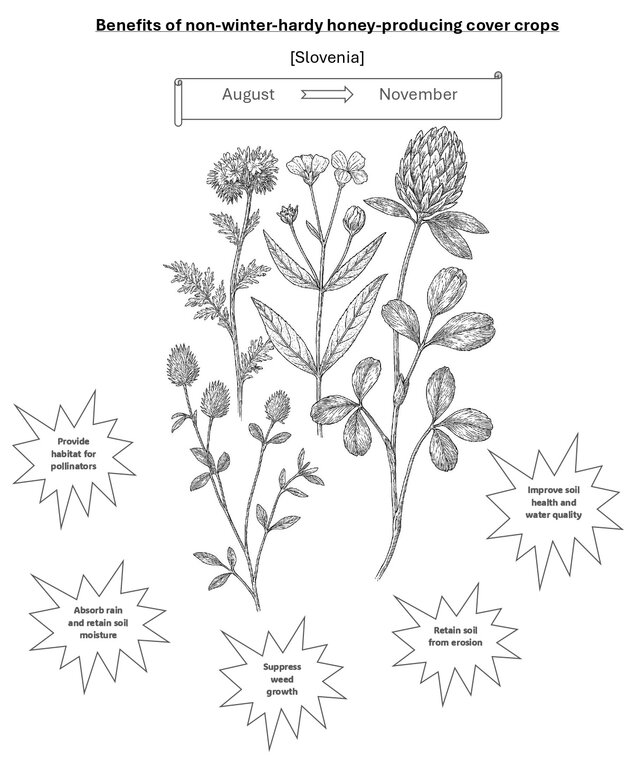Non-winter-hardy honey-producing cover crops [سلوفينيا]
- تاريخ الإنشاء:
- تحديث:
- جامع المعلومات: Gregor Kramberger
- المحرر: Tamara Korošec
- المراجعون: William Critchley, Rima Mekdaschi Studer
Neprezimni medonosni posevki
technologies_7463 - سلوفينيا
عرض الأقسام
توسيع الكل طي الكل1. معلومات عامة
1.2 تفاصيل الاتصال بالأشخاص الرئيسيين لمصدر المعلومات والمؤسسات المشاركة في تقييم وتوثيق التقنية
متخصص في الإدارة المستدامة للأراضي:
مستخدم الأرض:
Ropič Andrej
Farmer
سلوفينيا
جامع المعلومات المشارك:
Horvat Tomotej
Chamber of Agriculture and Forestry of Slovenia (KGZS) – Institute of Agriculture and Forestry Maribor
سلوفينيا
اسم المشروع الذي سهّل توثيق/تقييم التقنية (إذا كان ذلك على صلة)
OPtimal strategies to retAIN and re-use water and nutrients in small agricultural catchments across different soil-climatic regions in Europe (OPTAIN)اسم المؤسسة (المؤسسات) التي سهلت توثيق/تقييم التقنية (إذا كان ذلك على صلة)
Chamber of Agriculture and Forestry of Slovenia – Institute of Agriculture and Forestry Maribor (KGZS) - سلوفينيا1.3 الشروط المتعلقة باستخدام البيانات الموثقة من خلال WOCAT
يوافق جامع المعلومات والشخص (لاشخاص) الرئيسي لمصدر المعلومات على الشروط المتعلقة باستخدام البيانات الموثقة من خلال WOCAT:
نعم
1.4 إعلان بشأن استدامة التقنية الموصوفة
هل التقنية الموصوفة هنا تمثل مشكلة فيما يتعلق بتدهور الأراضي، بحيث لا يمكن إعلانها تقنية مستدامة لإدارة الأراضي؟:
كلا
2. وصف تقنيةالإدارة المستدامي للأراضي
2.1 وصف مختصر للتقنية
تعريف التقنية:
Non-winter-hardy honey-producing cover crops enhance soil fertility, prevent erosion, reduce nutrient leaching, and support biodiversity. These fast-growing, flowering plants are integrated into crop rotation, offering ecological and long-term economic benefits - and are supported by EU agricultural subsidies.
2.2 وصف تفصيلي للتقنية
الوصف:
Cover cropping with non-winter-hardy honey-producing mixtures is expanding on arable land in Slovenia, especially in lowland areas near water protection zones, streams, and other water bodies. These plants are often integrated into crop rotations of both conventional and organic farming systems. Together with winter-hardy cover crops, these mixtures are an essential component of good sustainable land management. Supported by the EU's Common Agricultural Policy through SOPO (Schemes for Climate and Environment) and KOPOP (Agri-Environmental-Climate Payments), this technology promotes sustainable agriculture by improving soil structure and health and preventing nutrient leaching.
Cover crops - also referred to as catch crops or green manures - are fast-growing, plants from various families, mostly legumes, grasses and brassicas. After the main crop harvest, these plants are sown and cover the soil during summer, autumn, and winter. We distinguish between winter-hardy and non-winter-hardy cover crops.
One of the most popular non-winter-hardy mixtures used in Slovenia, includes Egyptian clover (Trifolium alexandrinum), red clover (Trifolium pratense), phacelia (Phacelia tanacetifolia), and niger (Guizotia abyssinica). These species are drought-tolerant, support pollinators, and naturally perish after the first frost, simplifying subsequent soil preparation.
Their main functions are to improve soil fertility, retain moisture, prevent erosion, and reduce nutrient leaching into waterways. The different characteristics of the species in the mixture combine multiple advantages:
- dissimilar root systems extract nutrients from different layers of the soil;
- the various plant species extract different root exudates, which serve as a nutrient source for soil microorganisms;
- compacted soils become loose and of better structure;
- these species combined lead to enriched organic matter and humus;
- flowering species provide forage for pollinators;
- an overall impact is a reduced need for fertilizers and pesticides which in turn enhances water quality and lowers environmental risks;
- the leguminous species in the mixture fix nitrogen from the air, and follow-up crops like maize require less fertilizer, reducing greenhouse gas emissions.
Honey-producing non-winter-hardy mixtures are typically included in multi-year crop rotation plans. Activities involve selecting appropriate plant species/varieties or mixtures or species/varieties based on soil, climate, rotation and function requirements.
Shallow cultivation or direct sowing on well-prepared seedbeds takes place after cereal harvest, generally in July and August, with a recommended seeding rate of 12 kg/ha. Farmers usually avoid additional fertilization, as soil nutrients suffice for the growth of cover crops. Minimal maintenance is needed during growth since these plants suppress weeds and reduce pest pressure. Termination involves natural frost die-off, mulching, rolling, or shallow tillage. Detailed record-keeping ensures compliance with subsidy programs and supports long-term benefits.
Farmers value such cover cropping for its multiple benefits. They very much appreciate the subsidies they get for their additional effort to sow cover crops. However, challenges include higher initial costs, dependency on appropriate weather, complex timing of operations, and potential competition with main crops. Despite these hurdles, many farmers see cover cropping as a critical component of sustainable farming practices.
2.3 صور التقنية
2.5 البلد/المنطقة/المواقع التي تم تنفيذ التقنية فيها والتي يغطيها هذا التقييم
البلد:
سلوفينيا
المنطقة/الولاية/المحافظة:
Jareninski dol, Pernica
مزيد من التفاصيل حول الموقع:
Vosek
حدد انتشار التقنية:
- منتشرة بالتساوي على مساحة
إذا كانت التقنيةا موزعة بالتساوي على منطقة ما، حدد المساحة المغطاة (بالكيلومتر المربع):
137,0
هل يقع موقع/مواقع التقنية في منطقة محمية بشكل دائم؟:
كلا
Map
×2.6 تاريخ التنفيذ
اذكر سنة التنفيذ:
2020
في حالة عدم معرفة السنة بالتحديد، يرجى الإشارة إلى التاريخ التقريبي:
- منذ أقل من 10 سنوات (مؤخرًا)
2.7 إدخال التقنية
حدد كيف تم إدخال التقنية:
- من خلال ابتكار مستخدمي الأراضي
- أثناء التجارب/الأبحاث
التعليقات (نوع المشروع، الخ):
The farmer adopted cover cropping as part of his transition to low-tillage farming, supported by experimentation and guidance from the public advisory service. The measure, backed by CAP subsidies, was adopted after research and experimentation, ensuring its effective integration into his farming system.
3. تصنيف تقنية الإدارة المستدامي للأراضي
3.1 الغرض الرئيسي ( الأغراض الرئيسية) للتقنية
- تحسين الإنتاج
- الحد من تدهور الأراضي ومنعه وعكسه
- الحفاظ على النظام البيئي
- حماية مستجمعات المياه / المناطق الواقعة في اتجاه مجرى النهر - مع تقنيات أخرى
- الحفاظ على/تحسين التنوع البيولوجي
3.2 نوع (أنواع) استخدام الأراضي الحالية حيث يتم تطبيق التقنية
استخدامات الأراضي مختلطة ضمن نفس وحدة الأرض:
كلا
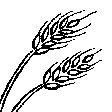
الأراضي الزراعية
- زراعة سنوية
الزراعة السنوية - حدد المحاصيل:
- الحبوب - الشعير
- الحبوب - الذرة
- الحبوب - قمح (شتوي)
عدد مواسم الزراعة في السنة:
- 1
هل يتم ممارسة الزراعة البينية؟:
نعم
إذا كانت الإجابة بنعم، حدد المحاصيل التي يتم زراعتها بشكل بيني:
The first year of the rotation comprises a mix of grasses and legumes
هل تتم ممارسة تناوب المحاصيل؟:
نعم
إذا كانت الإجابة بنعم، حدد:
The farmer practices a 4- to 5-year crop rotation plan, primarily involving maize and winter cereals. After the harvest of winter cereals (e.g., wheat) in July, cover crops are sown in early August to protect the soil, enhance fertility, and support low-tillage practices.
3.3 هل تغير استخدام الأراضي نتيجة لتنفيذ التقنية؟
هل تغير استخدام الأراضي نتيجة لتنفيذ التقنية؟:
- لا (تابع مع السؤال 3.4)
3.4 إمدادات المياه
إمدادات المياه للأرض التي يتم تنفيذ التقنية عليها:
- بعلية
3.5 مجموعةالإدارة المستدامة للأراضي التي تنتمي إليها هذه التقنية
- تحسين الغطاء الأرضي/النباتي
- الحد الأدنى من اختلال التربة
- الإدارة المتكاملة لخصوبة التربة
3.6 التدابير التقنية في مجال إلادارة المستدامة للأراضي
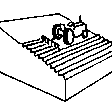
التدابير الزراعية
- A1: الغطاء النباتي/التربة
- A2: المادة العضوية/خصوبة التربة
- A6: إدارة المخلفات
A6:حدد إدارة المخلفات:
A 6.4:تم الاحتفاظ بها
3.7 الأنواع الرئيسية من تدهور الأراضي التي تناولتها التقنية
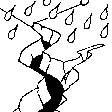
تآكل التربة بالمياه
- الوزن(Wt): فقدان التربة السطحية/تآكل السطح
- (Wg):الانجراف الخلجاني/ الخلجان
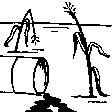
التدهور الكيميائي للتربة
- (Cn): تراجع الخصوبة وانخفاض محتوى المادة العضوية (غير ناتج عن الانجراف)
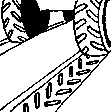
التدهور المادي أو الفيزيائي للتربة
- (Pc) : تراص التربة
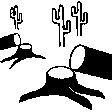
التدهور البيولوجي
- (Bc): تناقص الغطاء النباتي
- (Bq): انخفاض الكمية/الكتلة الحيوية
- (Bl): فقدان الحياة بالتربة
- (Bp): زيادة الآفات/الأمراض، وفقدان الحيوانات المفترسة
3.8 منع أو حد أو عكس تدهور الأراضي
تحديد هدف التقنية فيما يتعلق بتدهور الأراضي:
- منع تدهور الأراضي
- الحد من تدهور الأراضي
4. المواصفات الفنية، وأنشطة التنفيذ، والمدخلات، والتكاليف
4.1 الرسم الفني للتقنية
المواصفات الفنية (المتعلقة بالرسم الفني):
Technical specifications for sowing non-winter-hardy honey-producing mixture
Sowing time: Sowing is recommended immediately after the harvest of winter cereals, in late July or early August.
Seeding rate: 12 kg/ha
Soil preparation: High-quality seedbed preparation is necessary due to the small seed size. Blind sowing is recommended to destroy or prevent the growth of weeds.
Sowing depth: Seeds are sown shallowly, typically at a depth of 1–2 cm, depending on soil conditions.
Row spacing: Cover crops are typically sown using a grain drill with a row spacing of 12.5 cm (approximately 5 inches) or broadcasted using a fertilizer spreader. Drilling ensures precise seed placement and consistent depth, promoting uniform germination. Broadcasting, on the other hand, involves spreading seeds evenly across the soil surface, often followed by light incorporation to enhance seed-to-soil contact. Both methods are widely used, with the choice depending on specific field conditions and equipment. Plant height: Plants in the mixture grow to a height of 50–100 cm, depending on the varieties used and growing conditions.
Winter hardiness: The plants in the mixture are non-winter-hardy; they perish with the first autumn frost, simplifying autumn or spring plowing.
Suitability for crop rotation: The mixture integrates well into crop rotation as species in it are not related to cash crops. It is sown after the harvest of winter cereals and other early/spring cash crops.
This mixture is particularly suitable for water protection areas as its intense growth prevents the leaching of excess nitrogen from the soil into groundwater, improves the water-holding capacity of the soil and effectively suppresses erosion and weeds. Additionally, its colorful flowers during the summer months enliven the landscape and provide a rich source of nectar for bees and other pollinators.
المؤلف:
Gregor Kramberger
التاريخ:
21/07/2025
4.2 معلومات عامة بخصوص حساب المدخلات والتكاليف
حدد كيفية احتساب التكاليف والمدخلات:
- حسب مساحة تنفيذ التقنية
الإشارة إلى حجم ووحدة المساحة:
11.44 ha
في حالة استخدام وحدة مساحة محلية، قم بالإشارة إلى عامل التحويل إلى هكتار واحد (على سبيل المثال، 1 هكتار = 2.47 فدان): 1 هكتار =:
ha = 10.000 m2
عملة أخرى/ عملة وطنية (حدد):
EUR
إذا كان ذا صلة، وضح سعر الصرف من الدولار الأمريكي إلى العملة المحلية (على سبيل المثال، 1 دولار أمريكي = 79.9 ريال برازيلي): 1 دولار أمريكي =:
0,85
اذكر متوسط تكلفة أجر العمالة المستأجرة في اليوم الواحد:
114
4.3 أنشطة التأسيس
| النشاط | التوقيت (الموسم) | |
|---|---|---|
| 1. | Purchase of a disc harrow with cover crops seed drill | 1st year |
التعليقات:
The use of a disc harrow with a cover crop seed drill can support soil preparation and sowing, but it is not strictly necessary. Many farmers use other types of harrows and seeders, which may be more cost-effective or already available on the farm. In some cases, such equipment is shared or acquired through collective investment. While the typical depreciation period for this type of machinery is around 12 years, it is often used for 20 to 30 years, or as long as it remains functional and economically viable.
4.4 التكاليف والمدخلات اللازمة للتأسيس
| تحديد المدخلات | الوحدة | الكمية | التكاليف لكل وحدة | إجمالي التكاليف لكل مدخل | % من التكاليف التي يتحملها مستخدمو الأراضي | |
|---|---|---|---|---|---|---|
| معدات | Disc harrow with cover crops seed drill | piece | 1,0 | 20000,0 | 20000,0 | 70,0 |
| إجمالي تكاليف إنشاء التقنية | 20000,0 | |||||
| إجمالي تكاليف إنشاء التقنية بالدولار الأمريكي | 23529,41 | |||||
إذا تحمل مستخدم الأرض أقل من 100% من التكاليف، حدد من قام بتغطية التكاليف المتبقية:
Part of the agricultural machinery intended for the implementation of environmental measures can be funded through non-repayable grants from European and national funds under the CAP.
التعليقات:
The cost of such machinery is a key factor, as equipment like a disc harrow with a seed drill can be expensive. However, it should last for 20 years (or more). Furthermore, it is not strictly necessary, many farmers use simpler or existing machinery, and shared or collective investment is also common.
4.5 الصيانة/الأنشطة المتكررة
| النشاط | التوقيت/الوتيرة | |
|---|---|---|
| 1. | Variable costs of honey-producing non-winter-hardy cover crops | Every year. |
التعليقات:
Variable costs represent the total production expenses for sowing the mixture, including seeds, machinery and labor costs and financing.
4.6 التكاليف والمدخلات اللازمة للصيانة/للأنشطة المتكررة (سنويًا)
| تحديد المدخلات | الوحدة | الكمية | التكاليف لكل وحدة | إجمالي التكاليف لكل مدخل | % من التكاليف التي يتحملها مستخدمو الأراضي | |
|---|---|---|---|---|---|---|
| العمالة | Work with machines | hour | 52,0 | 9,0 | 468,0 | 100,0 |
| معدات | Seedbed preparation and sowing | hour | 23,0 | 35,2 | 809,6 | 100,0 |
| معدات | Mulching | hour | 29,0 | 32,0 | 928,0 | 100,0 |
| المواد النباتية | Seed | ha | 11,44 | 79,2 | 906,05 | 100,0 |
| غير ذلك | Financing cost | % | 0,03 | 3089,94 | 92,7 | 100,0 |
| إجمالي تكاليف صيانة التقنية | 3204,35 | |||||
| إجمالي تكاليف صيانة التقنية بالدولار الأمريكي | 3769,82 | |||||
التعليقات:
The farmer cultivates a total of 28.6 hectares of arable land. The area is theoretically divided into five equal parts, as it follows a 5-year crop rotation system. Additionally, a cover crop is sown after barley and wheat. Therefore, we have accounted for costs on 2/5 of the additional total area.
4.7 أهم العوامل المؤثرة على التكاليف
قدم وصفا لأهم العوامل التي تؤثر على التكاليف:
The total area is theoretically divided into five equal parts, following the 5-year crop rotation system. However, in practice, this division is not perfectly even. Other important cost factors include variations in input prices (such as seeds, fertilizers, and plant protection products), machinery costs, labor availability, and weather conditions that impact yields and operational efficiency.
5. البيئة الطبيعية والبشرية
5.1 المناخ
هطول الأمطار السنوي
- < 250 مم
- 251- 500 ملم
- 501 - 750ملم
- 1,000-751 ملم
- 1,500-1,100 ملم
- 2,000-1,500 ملم
- 3,000-2,001 ملم
- 4,000-3,100 ملم
- > 4000 ملم
حدد متوسط هطول الأمطار السنوي (إذا كان معروفًا)، بالملليمتر:
1032,00
المواصفات/التعليقات على هطول الأمطار:
Most precipitation falls in summer, the months with the highest average precipitation are August and September, the least precipitation falls in winter, in January and February at least, and in principle more precipitation falls in autumn than in spring.
الإشارة إلى اسم محطة الأرصاد الجوية المرجعية المعنية:
Jareninski Vrh (1991-2020)
المنطقة المناخية الزراعية
- شبه رطبة
The average annual air temperature at Jareninski Vrh during the reference period 1991–2020 was 10.1 °C.
5.2 طوبوغرافيا
متوسط الانحدارات:
- مسطح (0-2%)
- بسيط (3-5%)
- معتدل (6-10%)
- متدحرج (11-15%)
- تلال (16-30%)
- شديدة الانحدار(31-60%)
- فائقة الانحدار (>60%)
التضاريس:
- هضاب/سهول
- أثلام مرتفعة
- المنحدرات الجبلية
- منحدرات التلال
- منحدرات في السفوح
- قاع الوادي
المنطقة الارتفاعية:
- 100-0 متر فوق سطح البحر
- 500-101 متر فوق سطح البحر
- 1,000-501 متر فوق سطح البحر
- 1,500-1,001 متر فوق سطح البحر
- 2,000-1,501 متر فوق سطح البحر
- 2,500-2,100 متر فوق سطح البحر
- 3,000-2,501 متر فوق سطح البحر
- 4,000-3,001 متر فوق سطح البحر
- > 4000 متر فوق سطح البحر
وضح ما إذا كانت التقنية مطبقة على وجه التحديد في:
- غير ذات صلة
5.3 التربة
متوسط عمق التربة:
- ضحل جدًا (0-20 سم)
- ضحلة (21-50 سم)
- متوسطة العمق (51-80 سم)
- عميقة (81-120 سم)
- عميقة جدًا (> 120 سم)
قوام التربة (التربة السطحية):
- متوسط ( طميي، سلتي)
قوام التربة (> 20 سم تحت السطح):
- متوسط ( طميي، سلتي)
المواد العضوية في التربة السطحية:
- متوسطة (1-3%)
5.4 توافر المياه ونوعيتها
منسوب المياه الجوفية:
50-5 م
توافر المياه السطحية:
جيد
نوعية المياه (غير المعالجة):
للاستخدام الزراعي فقط (الري)
تشير جودة المياه إلى:
المياه السطحية
هل تعتبر ملوحة الماء مشكلة؟:
كلا
هل تحدث فيضانات في المنطقة؟:
نعم
الإنتظام:
بشكل عرضي
تعليقات ومواصفات أخرى بشأن نوعية المياه وكميتها:
Hydromelioration was carried out in the area, a drainage system and water retention systems (e.g. ponds and basins) were arranged.
5.5 التنوع البيولوجي
تنوع الأنواع:
- متوسط
تنوع الموائل:
- متوسط
5.6 خصائص مستخدمي الأراضي الذين يطبقون التقنية
مستقر أو مرتحل:
- غير المترحل
التوجه السوقي لنظام الإنتاج:
- تجاري/سوق
الدخل من خارج المزرعة:
- 10-50% من جميع الإيرادات
المستوى النسبي للثروة:
- متوسط
أفراداً أو مجموعات:
- فرد/أسرة معيشية
مستوى المكننة:
- ميكانيكية/ مزودة بمحرك
الجنس:
- رجال
عمر مستخدمي الأرضي:
- متوسط العمر
5.7 متوسط مساحة الأرض التي يستخدمها مستخدمو الأراضي الذين يطبقون التقنية
- < 0.5 هكتارا
- 0.5 - 1 هكتار
- 1 -2 هكتار
- 2 - 5 هكتار
- 5 - 15 هكتار
- 15 - 50 هكتار
- 50 - 100هكتار
- 500-100 هكتار
- 1,000-500 هكتار
- 10,000-1,000 هكتار
- > 10,000 هكتار
هل يعتبر هذا نطاقًا صغيرًا أو متوسطًا أو واسعا (في إشارة إلى السياق المحلي)؟:
- على نطاق متوسط
التعليقات:
In 2023, the average agricultural holding in Slovenia manages 8.8 hectares of utilized agricultural land.
5.8 ملكية الأراضي، وحقوق استخدام الأراضي، وحقوق استخدام المياه
ملكية الارض:
- فردية، يوجد سند ملكية
حقوق استخدام الأراضي:
- مؤجر
- فردي
حقوق استخدام المياه:
- مجتمعي (منظم)
هل تعتمد حقوق استخدام الأراضي على نظام قانوني تقليدي؟:
كلا
حدد:
Based on national legal system.
5.9 الوصول إلى الخدمات والبنية التحتية
الصحة:
- ضعيف
- معتدل
- جيد
التعليم:
- ضعيف
- معتدل
- جيد
المساعدة التقنية:
- ضعيف
- معتدل
- جيد
العمل (على سبيل المثال خارج المزرعة):
- ضعيف
- معتدل
- جيد
الأسواق:
- ضعيف
- معتدل
- جيد
الطاقة:
- ضعيف
- معتدل
- جيد
الطرق والنقل:
- ضعيف
- معتدل
- جيد
مياه الشرب وخدمات الصرف الصحي:
- ضعيف
- معتدل
- جيد
الخدمات المالية:
- ضعيف
- معتدل
- جيد
6. الآثار والتصريحات الختامية
6.1 الآثار التي أظهرتها التقنية في الموقع
الآثار الاجتماعية والاقتصادية
الإنتاج
إنتاج المحاصيل
التعليقات/ حدد:
Cover crops improve soil fertility, moisture retention, and nutrient availability, leading to slight yield improvements in the following crop. The impact depends on crop rotation, soil conditions, and cover crop management.
إنتاج الأعلاف
التعليقات/ حدد:
Cover crops used in this system are not intended for grazing or fodder production; their role is primarily soil conservation and fertility enhancement. Usually, they are incorporated into the soil.
إدارة الأراضي
التعليقات/ حدد:
Cover crops enhance soil conservation, reduce the need for intensive tillage, and improve crop rotation efficiency.
الدخل والتكاليف
النفقات على المدخلات الزراعية
التعليقات/ حدد:
Cover crops reduce the need for fertilizers and herbicides, but additional costs for seeds and labor partially offset these savings.
دخل المزرعة
التعليقات/ حدد:
Cover crops require an initial investment, but long-term benefits such as reduced input costs and improved soil fertility may positively impact farm income over time.
عبء العمل
التعليقات/ حدد:
Additional labor required for sowing and managing cover crops.
الآثار الايكولوجية
دورة المياه / الجريان السطحي
التبخر
التعليقات/ حدد:
Cover crops reduce direct soil exposure, lowering evaporation and improving water retention.
التربة
رطوبة التربة
التعليقات/ حدد:
Cover crops enhance soil moisture by reducing evaporation and improving water infiltration.
غطاء التربة
التعليقات/ حدد:
Cover crops provide continuous ground cover, protecting the soil from erosion, nutrient loss, and extreme weather conditions.
فقدان التربة
التعليقات/ حدد:
Cover crops significantly reduce soil loss by stabilizing the soil, preventing erosion, and improving infiltration.
التنوع البيولوجي: الغطاء النباتي، الحيوانات
الغطاء النباتي
التعليقات/ حدد:
Cover crops provide continuous plant cover, reducing bare soil exposure and enhancing biodiversity.
الكتلة الحيوية/ طبقة الكربون فوق التربة
التعليقات/ حدد:
Cover crops contribute significantly to above-ground biomass accumulation, increasing organic carbon input into the soil.
التنوع النباتي
التعليقات/ حدد:
Cover crops introduce multiple species into the cropping system, enhancing plant diversity and ecosystem resilience.
الأنواع المفيدة
التعليقات/ حدد:
Cover crops support pollinators, natural pest predators, and soil organisms, enhancing ecosystem balance.
تنوع الموائل
التعليقات/ حدد:
Cover crops create diverse habitats for pollinators, beneficial insects, and soil organisms, improving ecosystem resilience.
مكافحة الآفات/الأمراض
التعليقات/ حدد:
Cover crops help break pest and disease cycles, support beneficial insects, and improve soil health, reducing outbreaks.
الحد من مخاطر المناخ والكوارث
آثار الجفاف
التعليقات/ حدد:
Cover crops enhance water retention, reduce evaporation, and improve soil structure, making fields more resilient to drought.
حدد تقييم الآثار في الموقع (القياسات):
The data have not been obtained through specific measurements but rather through a questionnaire with the farmer and insights from other farms and agricultural advisors.
6.2 الآثار التي أظهرتها التقنية خارج الموقع
القدرة على التخفيف / الترشيح
التعليقات/ حدد:
Cover crops act as a natural buffer, reducing runoff, filtering pollutants, and preventing nutrient loss.
قيّم الآثار خارج الموقع (القياسات):
The data have not been obtained through specific measurements but rather through a questionnaire with the farmer and insights from other farms and agricultural advisors.
6.3 تعرض التقنية وحساسيتها لتغير المناخ التدريجي والظواهر المتطرفة/الكوارث المرتبطة بالمناخ (كما يراها مستخدمو الأراضي)
تغير مناخ تدريجي
تغير مناخ تدريجي
| الموسم | زيادة أو نقصان | كيف تتعامل التقنية مع ذلك؟ | |
|---|---|---|---|
| درجة الحرارة السنوية | زيادة | جيدا | |
| درجة الحرارة الموسمية | الصيف | زيادة | جيدا |
| درجة الحرارة الموسمية | الربيع | زيادة | باعتدال |
| درجة الحرارة الموسمية | الخريف | زيادة | جيدا |
| درجة الحرارة الموسمية | الشتاء | زيادة | باعتدال |
| هطول الأمطار الموسمية | الصيف | زيادة | جيدا |
| هطول الأمطار الموسمية | الربيع | زيادة | باعتدال |
| هطول الأمطار الموسمية | الخريف | انخفاض | جيدا |
الظواهر المتطرفة / الكوارث المرتبطة بالمناخ
الكوارث الجوية
| كيف تتعامل التقنية مع ذلك؟ | |
|---|---|
| عاصفة ممطرة محلية | جيدا |
الكوارث المناخية
| كيف تتعامل التقنية مع ذلك؟ | |
|---|---|
| موجة حر | جيدا |
| جفاف | جيدا |
6.4 تحليل التكلفة والعائد
كيف يمكن مقارنة العوائد نسبة لتكاليف الإنشاء (من وجهة نظر مستخدمي الأراضي)؟
عوائد قصيرة الأجل:
سلبي قليلا
عوائد طويلة الأجل:
إيجابي قليلا
كيف تتم مقارنة العوائدمع كلفة الصيانة/التكاليف المتكررة (من وجهة نظر مستخدمي الأراضي)؟
عوائد قصيرة الأجل:
محايد/متوازن
عوائد طويلة الأجل:
إيجابي
التعليقات:
In the short term, establishment costs are high machinery investment, with no direct financial return. However, in the long term, benefits such as improved soil fertility, reduced input costs, and better yields in crop rotation help offset initial expenses. In the short term, maintenance costs, such as seed, labor for sowing and termination, are balanced by reduced expenses on herbicides and fertilizers. Over the long term, cover cropping leads to lower input costs, improved soil health, and better yields in crop rotation
6.5 اعتماد التقنية
- 11-50%
من بين جميع الذين تبنوا التقنية، كم عدد الذين فعلوا ذلك بشكل تلقائي، أي دون تلقي أي حوافز مادية/مدفوعات؟:
- 10-0%
6.6 التكيف
هل تم تعديل التقنية مؤخرًا لتتكيف مع الظروف المتغيرة؟:
نعم
إذا كانت الإجابة بنعم، وضح الظروف المتغيرة التي تم تكييفها معها:
- الأسواق المتغيرة
حدد تكيف التقنية(التصميم، المواد/الأنواع، الخ.):
The composition of the cover crop mix was adjusted to better fit the crop rotation, improving soil fertility and weed suppression.
6.7 نقاط القوة / المزايا / الفرص التي توفرها التقنية
| نقاط القوة/ المزايا/ الفرص من وجهة نظر مستخدمي الأراضي |
|---|
| Improvement of soil fertility (improved soil structure, increased humus - organic matter content) |
| Soil erosion control (e.g., Pernica lake) |
| Weed control – suppression of weeds |
| Moisture retention in the soil (protection of soil against direct sun rays) |
| Long-term pest control |
| Easier soil cultivation - suitable for minimum tillage |
| Beneficial for bees and wild pollinators |
| Improved aesthetic value of the landscape |
| نقاط القوة/ المزايا/ الفرص من وجهة نظر جامع المعلومات أو غيره من الاشخاص الرئيسيين لمصدر المعلومات |
|---|
| Non-winter-hardy cover crops improve soil structure, increase organic matter content, increase the number and variety of soil (micro)organisms and enhance nutrient cycling, leading to more fertile and resilient soils. They also help in nutrient retention. |
| The root systems of cover crops help anchor the soil, reducing erosion caused by wind and water. |
| Continuous cover with cover crops can suppress weeds, reducing the need for herbicides. |
| Certain cover crops can break pest and disease cycles, contributing to healthier crops. |
| Honey producing non-winter-hardy cover crops support pollinators. |
6.8 نقاط ضعف / مساوىء / مخاطر التقنية وسبل التغلب عليها
| نقاط الضعف/ المساوىء/ المخاطر من وجهة نظر مستخدم الأراضي | كيف يمكن التغلب عليها؟ |
|---|---|
| Time- and labor-intensive, requiring significant coordination in terms of timing, weather, and other conditions to meet the deadlines set within the framework of the Common Agricultural Policy – CAP, if the farmer wants to get subsidies for this planting cover crops. | Farmers have greater influence in policy making. Bottom-up approach. |
| Additional seed cost. | The farmer enrolls in CAP measures to receive a subsidy for this measure. |
| Initial costs when purchasing equipment, additional investments, and changes in work technology. | Equipment rental, applying for funding grants for equipment, and modifying already existing machinery. |
| Complexity of management, more demanding planning, and necessary knowledge. | Education |
| Farm conditions vary, and the effectiveness of cover crops depends on soil type, climate, and local conditions, which can affect growth and overall benefits. | Selecting suitable cover crop mixtures adapted to local soil and climate conditions. Flexible management practices, regular monitoring, technical support, education. |
| Inappropriate use | Education |
| نقاط الضعف/ المساوىء/ المخاطر من وجهة نظر جامع المعلومات أو غيره من الاشخاص الرئيسيين لمصدر المعلومات | كيف يمكن التغلب عليها؟ |
|---|---|
| Establishing and terminating cover crops require additional time and labor, which can be a limiting factor for some farmers. | Good planning, collaboration with other farmers, subsidies, and awareness of the long-term benefits of this method encourages the farmer to be more willing to invest effort. |
| Additional costs for seed purchase and extra labor. | The farmer enrolls in CAP measures to receive a subsidy for this measure. |
| Potential challenges in soil preparation. | Appropriate equipment, planning, selection of the right plant varieties. |
| Complexity of crop management and planning. | Education, planning, record keeping. |
7. المراجع والروابط
7.1 طرق جمع/مصادر المعلومات
- مقابلات مع مستخدمي الأراضي
1 (Andrej Ropič, farmer)
- مقابلات مع المتخصصين/الخبراء في الإدارة المستدامة للأراضي
2 (Chamber of Agriculture and Forestry of Slovenia (KGZS) – Institute of Agriculture and Forestry Maribor; Tamara Korošec and Timotej Horvat)
- التجميع من التقارير والوثائق الأخرى الموجودة
CAP and Slovenian Strategic Plan 2023-2027.
متى تم تجميع البيانات (ميدانيا)؟:
17/01/2023
التعليقات:
Visit to the farm and farmer interview.
7.2 المراجع للمنشورات المتاحة
العنوان، المؤلف، السنة، النظام القياسي الدولي لترقيم الكتب ISBN:
Quintarelli, V., Radicetti, E., Allevato, E., Stazi, S. R., Haider, G., Abideen, Z., Bibi, S., Jamal, A., & Mancinelli, R. (2022). Cover Crops for Sustainable Cropping Systems: A Review. Agriculture, 12(12), 2076.
متاح من أين؟كم التكلفة؟:
https://doi.org/10.3390/agriculture12122076
7.3 روابط للمعلومات ذات الصلة على الإنترنت
العنوان/الوصف:
Ministry of Agriculture, Forestry and Food. (2024). Unified Application 2024: Guidelines for the implementation of interventions under the Strategic Plan of the Common Agricultural Policy 2023–2027. Ljubljana, Slovenia.
عنوان الرابط URL:
https://www.kgzs.si/uploads/eiv24/NAVODILA%201/00_VELIKA_NAVODILA_2024_-_CELOTA_-_28_5_24.pdf
العنوان/الوصف:
SARE: Cover Crops for Sustainable Crop Rotations
عنوان الرابط URL:
https://www.sare.org/resources/cover-crops/
العنوان/الوصف:
Recommendations for sowing catch crops and winter cover crops for the sustainable use of arable land (Priporočila za setev naknadnih in prezimnih posevkov, za trajnostno rabo njiv)
عنوان الرابط URL:
https://www.kmetijskizavod-nm.si/uploads/kgz_nm/travni%C5%A1tvo/Priporo%C4%8Dila_za_setev_naknadnih_in_prezimnih_posevkov.pdf
الروابط والوحدات المواضيعية
توسيع الكل طي الكلالروابط
لا يوجد روابط
الوحدات المواضيعية
لا يوجد وحدات مواضيعية


